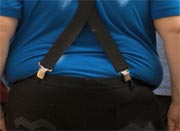- Skip Storing This Everyday Product in the Fridge Door
- Green Tea + B3 Pairing May Boost Brain Health
- Navigating Your Midlife Crisis: Embracing New Possibilities
- City Raccoons Showing Signs of Domestication
- Mapping the Exposome: Science Broadens Focus to Environmental Disease Triggers
- One Week Less on Social Media Linked to Better Mental Health
- Your Brain Changes in Stages as You Age, Study Finds
- Some Suicide Victims Show No Typical Warning Signs, Study Finds
- ByHeart Formula Faces Lawsuits After Babies Sickened With Botulism
- Switch to Vegan Diet Could Cut Your Greenhouse Gas Emissions in Half
Truck Drivers Top List of Overweight Workers


Truck drivers, cleaning-service employees and mechanics are among the most obese groups of workers, new research contends.
Not far behind are health-service workers and administrative and clerical personnel, the study out of Washington state found.
The multiyear survey didn’t draw a direct causal connection between types of jobs and excess weight. And the results apply only to Washington state.
And, one of the study’s authors said, the measurement used to determine obesity can be misleading when applied to muscular people. People such as fire fighters and construction workers might fall into this group.
Still, the report does suggest that some jobs are harder on the waistline than others. People working in sales and tech support, for instance, weigh more than doctors, lawyers and construction workers, according to the study.
“People spend about a third — or even half — of their waking hours in the workplace,” said study lead author Dr. David Bonauto, who’s with the Washington State Department of Labor and Industries.
“But not all work environments are alike,” Bonauto said. “With obesity a big public-health concern, the key message here is that any effort an employer can make toward promoting a healthier work environment and healthier behavior among employees in their particular work setting is going to be meaningful and helpful for both employee and employer.”
Bonauto and his colleagues reported their findings in the January issue of the U.S. Centers for Disease Control and Prevention’s journal Preventing Chronic Disease.
The authors analyzed results for odd years between 2003 and 2009 from an annual survey exploring eating habits, physical-activity routines and body-mass index (BMI). BMI is a measurement of body fat that takes height and weight into account.
The Washington survey was an expanded take on a standard CDC survey on behavioral risk factors. The state’s version also asked the nearly 38,000 employed participants (between ages 18 and 64) to note both their job title and the industry in which they worked.
Overall, nearly one-quarter of this group was found to be obese (defined as having a BMI of 30 or higher). This figure was in line with national survey findings of an average obesity rate of 27 percent. The highest in-state risk for obesity was seen among those who were older, male and less educated; made less money; and worked in jobs that were not physically demanding.
When broken down by occupation, obesity rates fluctuated significantly. For example, 12 percent of those employed as health care diagnosticians — such as doctors, dentists, veterinarians and optometrists — were found to be obese. That compared with nearly 39 percent of truck drivers.
Also on the high-risk end of the obesity scale were men and women involved in transporting and moving material (38 percent); protective-service workers, such as police, firefighters and emergency responders (33 percent); cleaning- and building-service employees (30 percent); mechanics and repairpersons (29 percent); administrative and clerical personnel (28 percent); salespeople (25 percent); and executives and managers (24 percent).
However, one issue with the findings, Bonauto said, “is that our measurement of obesity doesn’t account for people who are very muscular and have a lean body mass.”
“Being muscular tends to artificially inflate BMI,” he said. “Firemen or construction workers face a lot of physical demands at work and tend to be more muscular.”
Occupations associated with a low risk for obesity included natural and social scientists (17 percent); postsecondary school teachers (18 percent); those involved in non-diagnosing health care treatment (18 percent); architects, engineers and construction workers (20 percent); food prep workers (20 percent); lawyers and judges (22 percent); and computer scientists (22 percent).
Riskier professions also tended to have lower rates of fruit and vegetable intake, lower rates of physical activity and higher rates of smoking, the researchers said.
Exhibit A: Truck drivers were classified as being the most likely to smoke and the least likely to consume a minimal amount of five or more servings of fruits and vegetables per day.
“Working with this information can get a little tricky,” Bonauto said. “For example, I’d like to say our Washington numbers are easily comparable across states and regions. But there are employment variations, and we just don’t have the data for other states yet.”
Lona Sandon, a registered dietitian and assistant professor of clinical nutrition at the University of Texas Southwestern, in Dallas, expressed little surprise at the findings.
“While I wouldn’t advise people to choose their career based on this, it’s really no surprise that truck drivers top the list or that office workers chained to their desks have more issues with overweight and obesity,” Sandon said.
“The work environment definitely can affect one’s health,” she said. “Employers who make an effort to encourage and make accessible physical activity and healthy eating can make a difference — not just to their worker’s waistline, but also to their bottom line. A worker who’s healthy is a worker who’s more productive.”
More information
To find out more about healthy weight, visit the U.S. National Heart, Lung, and Blood Institute.
Source: HealthDay
Copyright © 2025 HealthDay. All rights reserved.










